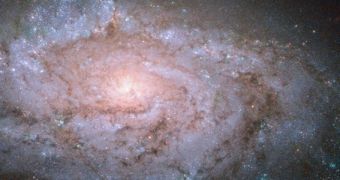Astronomers operating the NASA/ESA Hubble Space Telescope have recently captured an outstanding image of a cosmic structure called NGC 1084, which is a nearly perfect example of a spiral galaxy that lacks a bar at its core. About half of all spiral galaxies in the Universe lack this structure in their central regions. By comparison, the Milky Way is a barred spiral galaxy.
Though it may look like a generic spiral galaxy, NGC 1084 stands out precisely because of its average appearance. Many astronomers use it as an example of what a non-barred spiral galaxy looks like. In the recent study, Hubble was able to capture a near-perfect, face-on view of this object. NGC 1084 is located in the Eridanus constellation, the sixth largest of the 88 modern constellations.
It has an apparent magnitude of around 10.6, meaning it does not appear so bright in the night sky. The apparent magnitude of a celestial body, including stars and galaxies, is a measure that denotes how bright an object appears to astronomers on the surface of Earth when taking into account how the same object would look if our planet had no atmosphere.
Another thing that sets NGC 1084 apart from other galaxies is the fact that it is home to an impressive number of supernova remnants, structures left behind following the explosion of massive stars that reached the end of their burning cycle, or main sequence. Though observing supernova blasts directly is difficult to do, astronomers can learn more about them by studying these remnants.

 14 DAY TRIAL //
14 DAY TRIAL //